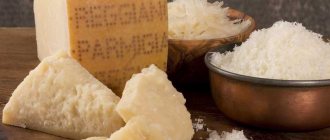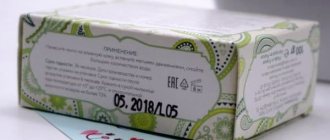Of course, virgin products are the best option. However, in everyday life it is not always possible to purchase fresh cow's milk. In such a situation, an excellent solution would be to use its powder analogue. Powdered milk retains its freshness and taste for a long time. This product can be used as an additive for tea and coffee or dissolved in water. Moreover, even this version of the product requires certain conditions, so it is important to know how to store milk powder.
How to choose
Only high-quality powdered milk can be stored for a long time. Therefore, it is important to choose it correctly:
- it is important to inspect the contents of the package, it should be crumbly, without lumps, and have a uniform structure;
- The composition should contain only natural ingredients, without preservatives.
During 2-3 months of storage in a warm place, the product may become sticky after opening. Powdered milk can be stored for up to a year in a cool place at temperatures up to +10 degrees. After this period, fat oxidation begins in the dry mixture, and it acquires an unpleasant aftertaste.
Milk can be whole or skim. By shade it is divided into white and cream. However, in any case, it must consist of homogeneous particles. Foreign inclusions with a yellowish or brownish tint indicate a violation of the product manufacturing technology.
It happens that milk powder has an off-taste. This indicates the use of low-quality raw materials or the use of vegetable fats. If the milk has a bitter aftertaste, it means that it was transported or stored at improper temperatures. Or the reason may be that the product has expired. There is no point in buying such powdered milk.
How to check quality in the store and at home
To choose a quality product, you need to know what to look for. The following criteria will be important:
- Compound. It should not contain fatty components of plant origin and any preservatives. The composition must contain exclusively cow's milk.
- Color. A cream or pure white shade is allowed. A violation of the manufacturing process is indicated by the presence of brown, yellowish inclusions.
- Consistency. The powder should be homogeneous and crumbly. Any inclusions are not allowed.
- Taste. A good product has a pleasant caramel taste. There should be no off-flavors. The appearance of bitterness indicates a delay.
- Solubility. High-quality powder does not produce sediment when diluted with liquid. The presence of undissolved particles is a characteristic sign of poor quality SM.
The box must be intact and undamaged, and the powder must be in a tightly sealed bag.
It is important to know!
After expiration of the shelf life, the product must be disposed of. It should not be used for preparing a drink or for other purposes.
Storage conditions
Storage conditions for powdered milk are prescribed by the manufacturer:
- As a rule, the standard storage temperature for powdered milk is from 0 to +10 degrees;
- At the same time, air humidity should not be more than 85%.
After the package is opened, you need to store the milk powder in a cool place. Pack it in advance in a glass sealed container.
First aid for poisoning
First aid for yogurt poisoning should begin from the moment the first signs of the disease appear. It should be aimed at removing pathogenic microbes and toxic products of their vital activity from the body. To do this you should:
- Carry out gastric lavage using the “restaurant” method. The patient is given two or three glasses of water with added salt to drink, after which they begin to apply pressure to the root of the tongue with a spoon or fingers. As a result, vomiting occurs, during which the remnants of the eaten infected food are removed from the stomach. This is done several times until water comes out without any admixture of food. Gastric lavage using this method can only be performed on conscious adults.
- Take a suspension of activated carbon. To prepare it, you should crush activated carbon tablets into powder (at the rate of one tablet for every ten kilograms of body weight) and mix it with a small amount of boiled water. Instead of activated carbon, it is allowed to take any other absorbents, in particular Smecta or Enterosgel.
Shelf life of milk powder
- The skim milk product retains its properties even after 3 years. The main requirement is that it must remain at a temperature of +10 degrees and a humidity not higher than 85%. In addition, the powder must be in a tightly sealed container.
- Whole milk powder will keep refrigerated for up to 8 months.
- If the temperature is not higher than 20 degrees and the humidity does not exceed acceptable values, then the product can be stored for up to 3 months.
- Formula for children containing powdered milk can be stored for 6 to 12 months, at a temperature range of 1 to 10 degrees.
- Unnatural powdered milk, which contains preservatives, stabilizers, and flavorings, can be stored for more than 5 years.
Of course, the fact that such a product can be preserved much longer than usual is a plus. Before opening, it can be stored without refrigeration.
Marking deadlines
Based on the requirements of GOST R 51074, the following information is applied to the powder packaging:
- about the composition of the product;
- its nutritional value, etc.;
- including the expiration date.
Since this product is included in the list of Decree No. 720, its use is prohibited if this suitability information is not indicated.
GOST R 51074 (clause 3.5.9) states that for food products that require certain temperature conditions, as well as air humidity, it is necessary to indicate storage conditions on consumer packaging. In addition, since this product is classified as canned milk, the manufacturer may indicate the conditions under which the formula should be stored after opening the package.
How long is the shelf life of milk powder according to GOST and what does it depend on?
The product can be whole and low-fat. The former has a shorter shelf life due to its fat content. And if it is violated, it will acquire a bitter taste. The safety of the product also depends on the packaging:
- If there is a plastic container, the temperature should be less than 10 degrees. Therefore, such milk is stored in the refrigerator;
- with cellophane or parchment packaging, temperatures up to 20 degrees and humidity up to 75% are permissible. If storage standards are violated, the product should be used within 3 months.
Modern GOSTs only indicate that such information must be prescribed by the manufacturer.
When is medical attention required?
Medical assistance is required in the following cases:
- poisoning occurred in a child, pregnant woman or elderly person;
- the patient has a high body temperature, which cannot be reduced using conventional methods;
- symptoms of poisoning persist for more than three days;
- the appearance of convulsions, severe weakness, loss of consciousness.
Medical care for yogurt poisoning includes the prescription of antidiarrheal drugs, antibacterial agents, and intravenous fluid administration.
Can I use it if the expiration date has expired?
Powdered milk is a product whose consumption is prohibited after the expiration date. Such a product can harm the body.
Read: How to store ryazhenka correctly and for how long
conclusions
- The storage period of powdered milk directly depends on compliance with the recommended temperature and humidity standards. It is optimal to store the product at a temperature of 1-10 degrees and the humidity should be no more than 85%.
- If the package is opened, it is better to pour the powder into a glass or plastic container that is hermetically sealed.
- The best option for storing milk powder is the refrigerator.
After the expiration date, its use is prohibited.
Regulatory Requirements
The expiration and/or storage dates are indicated on product packaging. These are different concepts.
- The expiration date is understood as a period of time after which the product cannot be consumed, even if all the requirements for its storage have been met exactly. In other words, compliance with this period guarantees that if stored correctly for the specified time, the product will not cause harm to health.
- The shelf life indicates that during this period the product retains the same qualities. After its expiration, such a guarantee no longer exists.
The shelf life cannot exceed the expiration date. In extreme cases, these two periods are equal.
As for powdered milk, GOST R 52791-2007 states that the manufacturer is obliged to establish storage conditions and the period during which it is considered suitable. A similar requirement is contained in Decree of the Government of the Russian Federation No. 720 of June 16, 1997.
The list provided in the appendix to this document contains “Dry milk products”. Those goods that are listed in the Resolution pose a danger to the health and life of the consumer after this period, which is counted from the date of production.
Compound
Currently, whole, skim and instant milk powder is produced.
Each of them differs from each other in the percentage of proteins, fats and carbohydrates. One thing remains the same - the content of vitamins, minerals and amino acids. So, the ready-to-use product contains:
- vitamins: A, B1, B2, B9, B12, D, choline, vitamins PP, E, C.
- microelements (per 100 g of milk powder): calcium - 1000 mg, sodium - 400 mg, potassium -1200 mg and phosphorus - 780 mg.
What you can do at home
Activities that can be done in case of dairy product poisoning at home:
- gastric lavage;
- taking enterosorbents (drugs that absorb and remove toxins that enter the gastrointestinal tract);
- To replenish the volume of lost fluid during diarrhea and vomiting, it is recommended to take large amounts of fluid in the form of mineral water without gases.
Need to know! A small child cannot do gastric lavage on his own. If the temperature rises and there is blood in the stool, antidiarrheal drugs are not prescribed.
Video: yogurt - good or bad?
Read further: Yogurt poisoning (expired) - treatment methods, consequences
How to quickly recover from food poisoning - real tips and tricks
Is it harmful to consume dairy products?
How to restore intestinal microflora after poisoning: methods
Myths and facts about colds
Article rating:
( 1 ratings, average: 5.00 out of 5)
Share with friends:
What is the powdered product?
Powdered milk is produced in a wide range by various manufacturers. At its core, the product is a concentrate that is obtained from a regular pasteurized drink.
This form of milk has many advantages:
- long shelf life;
- ease of transportation;
- compact packaging;
- preservation of all useful substances in the composition;
- opportunity to always have at hand.
The process of producing milk powder industrially includes several stages:
- Normalization, in which fat content is brought to the required level.
- Pasteurization - heating and subsequent cooling.
- Cooking/thickening.
- Homogenization – obtaining a substance that is homogeneous in composition.
- Drying using a special apparatus, resulting in the appearance of powder.
Powdered milk can be used in the diet of not only adults, but also children.
The video will show you how milk powder is produced:
What to do if the milk has gone bad
Don't be upset if you miss the deadline. Natural milk can be processed into kefir or yogurt. To do this, you need to buy a special starter and mix it with the heated sour product.
If the whey of kefir or milk begins to flake off, make cottage cheese. To do this, the liquid also needs to be heated, but not brought to a boil, so that the cottage cheese flakes are separated from the whey, and drained into a colander lined with gauze. After this, the gauze needs to be tied and hung over the sink to drain the remaining liquid.
Also, slightly sour milk and slightly expired kefir are an excellent base for pancakes.
What causes milk defects?
Milk defects are caused by poor quality feed, microflora entering the milk, incorrect processing technology, violation of storage conditions and periods, and other reasons. Consistency defects are caused by the activity of certain microorganisms.
Interesting materials:
Why can’t you heat a sauna in cold weather? Why can't you start with 2? Why should you not eat expired cereals? Why can't you insulate a house from the inside? Why can't you weld reinforcement in concrete? Why can't you cook compote in an aluminum pan? Why shouldn't you throw away tires? Why can't you get out of the swamp? Why can't you blow the solution out of a pipette? Why can't you fill a full tank of gasoline?
How long can dry powders be stored?
Many housewives prefer to use milk powder, and all because of the durability and ease of storage. You can take dried milk with you on a hike or travel and not be afraid that it will spoil, because you can open the package at any time and prepare a fresh product.
However, even dry milk powders have storage restrictions, failure to comply with which leads to a deterioration in taste and a decrease in the nutritional value of the finished drink.
What is the shelf life of milk powder when opened at home? This period depends on the type of powder. Whole dried milk product is stored much less than skim milk product because it has fat, which gradually becomes bitter.
It is strictly forbidden to keep good powder in the heat, as it will quickly deteriorate. If you keep dried milk at +20 °C (room temperature), it can be stored for 3 months, and if it is opened, you need to consume the product within 30 days. The powder diluted in water can be refrigerated for up to 72 hours.
To extend the shelf life of whole dairy products, after opening the package, pour the contents into airtight paper or glass containers and place them on the refrigerator shelf. Under this condition, the shelf life of whole milk powder after opening will be 7-8 months, and skim milk – 1 year.
Powdered milk is a dairy product made from natural pasteurized milk by condensing it and drying it in special drying devices. The method is quite gentle and preserves almost all the beneficial properties of the dairy product. Dried milk is widely used in the field of cooking and agriculture for feeding newborn livestock.
How to determine the freshness of sour cream
Sometimes the deadline hasn’t expired, and you keep it in the refrigerator, but you still have doubts: can you eat it? The adequacy of a product can be determined not only by shelf life, but also by external signs.
Fresh milk is white, homogeneous, without flakes, stray lumps of fat and foreign tastes and odors (except that melted and sterilized milk has a boiling taste).
Natalya Klimova, chief technologist at SAPK-Moloko (Podvorye holding)
If the milk is full-fat (4.7% or higher), the formation of a characteristic film is acceptable, which immediately disappears when stirred. Skim milk may have a slightly bluish tint, while sterilized milk may have a creamy tint.
Sour milk feels sour, and then a clot appears. It turns into curdled milk.
Fresh kefir has a uniform consistency. Due to mixed (lactic acid and alcohol) fermentation and special fermentation with kefir grains, gas formation is possible. Natalya Klimova notes that slight swelling of the kefir package is normal.
But for ryazhenka, on the contrary, this is a sign of damage. The product is produced by fermenting baked milk with the addition of special starter cultures. Fresh fermented baked milk is absolutely homogeneous, soft creamy in color and with a pleasant melted aftertaste.
The main sign of spoilage of fermented milk products is the appearance of watery whey on top.
According to GOST, stabilizers and thickeners cannot be added to sour cream. If the manufacturer has added a little powder, he does not have the right to write the word “sour cream” on the packaging. Therefore, all kinds of sour creams and sour cream products appeared in stores. They are cheaper than natural sour cream, but you need to carefully study the composition to see if there are any foreign additives inside.
Natalya Klimova explained that depending on the production method, yogurt can be liquid (drinkable) or creamy. In any case, the consistency of the fresh product should be uniform. With the tank production method (this is when the product is first fermented in a large container and then poured into containers), the protein coagulum of the product may be damaged. With thermostatic fermentation (when the starter is added to an already packaged product), the clot should be intact.
If yogurt has pieces of fruit, it should be moderately sweet and match the color and aroma of the filler.
Spoiled cottage cheese is easy to recognize by its taste: it is bitter.
Porridge with dry milk
A very tasty breakfast would be porridge made from milk powder. To do this, you need to take 25 g of milk powder and dilute it in one glass of warm water. This amount yields about 250 ml of a reconstituted drink with a fat content of 2.5%. As a rule, this amount is enough to prepare one serving of porridge.
To make a healthy breakfast for four people, you need to take 120 g of milk powder and 900 ml of warm water. Stir the ingredients continuously until the milk powder is completely dissolved in the water.
Beneficial features
The benefits of powdered milk are due to its composition, which is not inferior to natural milk that has undergone pasteurization. This product contains calcium, which is necessary to strengthen bone tissue.
Powdered milk also contains potassium, which has a beneficial effect on the activity of the cardiovascular system. It contains quite a lot of vitamin A, which improves visual acuity and skin condition. Given the vitamin D content, milk powder is an anti-rickets agent.
This product contains choline, which helps normalize cholesterol levels in the blood. Thanks to chlorine, you can get rid of swelling and cleanse the body.
Powdered milk is used to reconstitute milk or a milk drink, which can then be used like natural milk. In addition, creams, baked goods and other products are prepared on its basis. As mentioned earlier, it is widely used in recipes for many confectionery products.
Carbohydrates: 52.6g. (∼210.4 kcal)
Energy ratio (b|w|y): 39% | 2% | 62%
Powdered milk - powder (see.
photo), which is obtained by drying cow's milk. It was invented so that people could take this product with them on long trips and be able to enjoy it at any time, which is why it received a lot of positive reviews. This product has a caramel flavor.
The production of milk powder takes place in 2 stages: first, the milk is condensed and then dried. As a result, the product loses 85% of its volume. It is packaged in packages using inert gases, which ensures a longer shelf life.
Powdered milk contains a large amount of fat. Considering this, it is used in the recipe for making chocolate, as well as for making some candies. In general, this product is quite widely used in the food industry, as it is included in cereals, baby food, confectionery, condensed milk, yogurt, etc.











